Photos and article by MARGIE O’LOUGHLIN
Metro Blooms has been working with neighbors along alleyways in East Nokomis to create spaces that provide bird and pollinator habitat, and improve water quality. Alleys are often ignored aesthetically and always paved with impervious materials. They carry thousands of gallons of water, along with automobile oil, fertilizer, insecticide and pesticide run-off, directly into storm drains every year. The Blooming Alleys project helps solve these problems by:
• working with community members to design and install visually appealing rain gardens, pervious pavement, and native plantings to reduce the amount of runoff and pollution that would otherwise flow into storm drains;
• transforming alleyways into habitat corridors that attract birds and pollinators; and
• engaging neighbors in the design of their alley properties.
The Blooming Alleys project is the result of a partnership between Metro Blooms, the Nokomis East Neighborhood Association, the MN Clean Water Fund, the Minnehaha Watershed District, the City of Minneapolis and others.
Contact Metro Blooms through their website at www.metroblooms.org to learn more about participating in the Blooming Alleys project. Alley captains and/or homeowners are encouraged to inquire about buy-in costs, garden/paver options and how to apply for next year’s program.
The Blooming Alleys Bike Tour was the monthly Night Out With NENA event for July. Check their website at www.nokomiseast.org for future Night Out events.
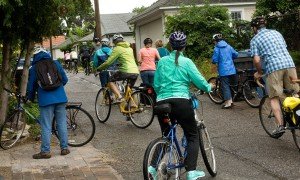 Photo left: More than two dozen bikers met at Sandcastle Restaurant on Lake Nokomis on the evening of July 14 to tour the neighborhood’s six blooming alleys. They set out in a rainstorm for a tour that encircled about half of Lake Nokomis. Each alley had a different spokesperson waiting for them, either a Metro Blooms employee who had participated in the project or a homeowner.
Photo left: More than two dozen bikers met at Sandcastle Restaurant on Lake Nokomis on the evening of July 14 to tour the neighborhood’s six blooming alleys. They set out in a rainstorm for a tour that encircled about half of Lake Nokomis. Each alley had a different spokesperson waiting for them, either a Metro Blooms employee who had participated in the project or a homeowner.
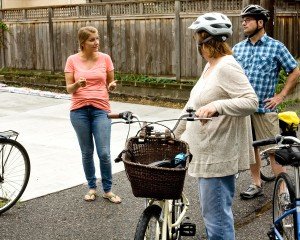 Photo right: Laura Scholl, director of Environmental Projects for Metro Blooms said, “All of the funding comes into play because of the water quality aspect.” As the saying goes, everybody lives downstream.
Photo right: Laura Scholl, director of Environmental Projects for Metro Blooms said, “All of the funding comes into play because of the water quality aspect.” As the saying goes, everybody lives downstream.
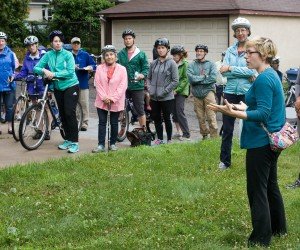 Photo left: At the first stop, Metro Blooms garden designer Lacy Campbell explained the difference between native plantings, rain gardens, and bioswales for different alley garden settings. “Every site is different, and provides its own challenges,” she said. ”We work with each participating homeowner to find the best solution while creating a common aesthetic for the alley.”
Photo left: At the first stop, Metro Blooms garden designer Lacy Campbell explained the difference between native plantings, rain gardens, and bioswales for different alley garden settings. “Every site is different, and provides its own challenges,” she said. ”We work with each participating homeowner to find the best solution while creating a common aesthetic for the alley.”
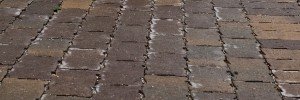 Photo right: Photo Above: Pervious pavers are a much more environmentally friendly choice than asphalt or concrete. Water is allowed to penetrate into the ground between pavers, which decreases run-off into Lake Nokomis. Pervious pavers may be installed as a buffer between where the driveway meets the alley.
Photo right: Photo Above: Pervious pavers are a much more environmentally friendly choice than asphalt or concrete. Water is allowed to penetrate into the ground between pavers, which decreases run-off into Lake Nokomis. Pervious pavers may be installed as a buffer between where the driveway meets the alley.
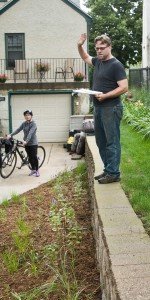 Photo left: Metro Blooms garden designer Rich Harrison indicated where a downspout had previously run the length of this home’s driveway and emptied its contents into the alley. The homeowners chose to remove the downspout, and instead planted a rain garden to contain rain water. Harrison explained, ”One of the best things about planting rain gardens is that they capture suspended solids like phosphorous, a main contributor to algae growth and water pollution. He continued,” Most rain gardens are dug down at least six inches, and can hold significant amounts of water from 1” rain events.
Photo left: Metro Blooms garden designer Rich Harrison indicated where a downspout had previously run the length of this home’s driveway and emptied its contents into the alley. The homeowners chose to remove the downspout, and instead planted a rain garden to contain rain water. Harrison explained, ”One of the best things about planting rain gardens is that they capture suspended solids like phosphorous, a main contributor to algae growth and water pollution. He continued,” Most rain gardens are dug down at least six inches, and can hold significant amounts of water from 1” rain events.
Comments
No comments on this item Please log in to comment by clicking here